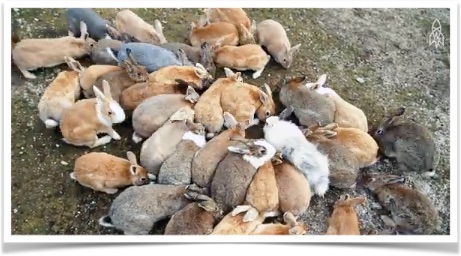
Okunoshima Island (slow) slow
Okunoshima Island (fast) fast

| 日本語 | English | ひらがな |
|---|---|---|
| 大久野島 | Okunoshima Island | おおくのしま |
| 大久野島は瀬戸内海に浮かぶ小さい島です | Okunoshima Island is an island that rises up in the Seto Inland Sea | おおくのしま は せとないかい に うかぶ ちいさい しま です |
| 広島県の竹原市に位置します | is located in Takehara City of Hiroshima Prefecture | ひろしまけん の たけはらし に いち します |
| かつて | at one time | かつて |
| 毒ガス工場の島として | as the poison gas factory island | どく ガス こうじょう の しま として |
| 世界大戦中は地図から削除されていました | during the world war (it) was deleted from maps | せかい たいせん-ちゅう は ちず から さくじょ されて いました |
| 現在 | currently | げんざい |
| 国立公園に指定されています | is designated as a national park | こくりつ こうえん に してい されて います |
| また | also | また |
| 今では大久野島と言えば | when speaking of Okunoshima Island | いま で は おおくのしま と いえば |
| 「毒ガス工場の島」ではなく、「うさぎの島」として知られています | is not known as the ‘poison gas island’ but rather ‘rabbit island’ | 「 どく ガス こうじょう の しま」 で は なく、 「 うさぎ の しま」 と して しられて います |
| この島に | on this island | この しま に |
| 700羽以上の野うさぎが棲息しています | over 700 rabbits (hares) inhabit… ♦羽(ha) is a counter used for birds and strangely rabbits. One often heard theory for its origin is that Buddhist monks, who were barred from eating meat other than birds, conveniently reclassified them as flightless birds. | なな ひゃく わ いじょう の のうさぎ が せいそく して います |
| うさぎがこの島に来た諸説は色々あります | there are various explantions of (how) the rabbits came to the island | うさぎ が この しま に きた しょせつ は いろいろ あります |
| 1つ目は | as for the first | ひとつめ は |
| 地元の小学校で飼っていたウサギ | rabbits kept at a local elementary school (not on this island) | じもと の しょうがっこう で かって いた ウサギ |
| 飼えなくなって | they couldn’t take care of them anymore | かえなくなって |
| 無人島のこの島に8羽持ってこられたという説 | the explanation that eight rabbits were brought to the uninhabited island | むじん-とう の この しま に はち わ もって こられた と いう せつ |
| ウサギ小さく可愛い為 | since rabbits are tiny and cute | ウサギ ちいさく かわいい ため |
| この島が観光地になった時にウサギを飼い始めた | when the island became a tourist spot, they started keeping rabbits | この しま が かんこうち に なった とき に ウサギ を かいはじめた |
| その結果 | the result | その けっか |
| 大久野島でウサギがたくさん増えたという説です | the explanation that the (number of) rabbits on the island increased | おおくのしま で ウサギ が たくさん ふえた と いう せつ です |
Okunoshima Island おおくのしま
Okunoshima Island is an island that rises up in the Seto Inland Sea おおくのしま は せとないかい に うかぶ ちいさい しま です
is located in Takehara City of Hiroshima Prefecture ひろしまけん の たけはらし に いち します
at one time かつて
as the poison gas factory island どく ガス こうじょう の しま として
during the world war (it) was deleted from maps せかい たいせん-ちゅう は ちず から さくじょ されて いました
currently げんざい
is designated as a national park こくりつ こうえん に してい されて います
also また
when speaking of Okunoshima Island いま で は おおくのしま と いえば
is not known as the ‘poison gas island’ but rather ‘rabbit island’ 「 どく ガス こうじょう の しま」 で は なく、 「 うさぎ の しま」 と して しられて います
on this island この しま に
over 700 rabbits (hares) inhabit… ♦羽(ha) is a counter used for birds and strangely rabbits. One commonly heard theory for its origin is that Buddhist monks, who were barred from eating meat other than birds, conveniently reclassified them as flightless birds. なな ひゃく わ いじょう の のうさぎ が せいそく して います
there are various explanations of (how) the rabbits came to the island うさぎ が この しま に きた しょせつ は いろいろ あります
as for the first ひとつめ は
rabbits kept at a local elementary school (not on this island) じもと の しょうがっこう で かって いた ウサギ
they couldn’t take care of them anymore かえなくなって
the explanation that eight rabbits were brought to the uninhabited island むじん-とう の この しま に はち わ もって こられた と いう せつ
since rabbits are tiny and cute ウサギ ちいさく かわいい ため
when the island became a tourist spot, they started keeping rabbits この しま が かんこうち に なった とき に ウサギ を かいはじめた
the result その けっか
the explanation that the (number of) rabbits on the island increased おおくのしま で ウサギ が たくさん ふえた と いう せつ です
